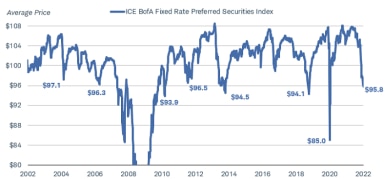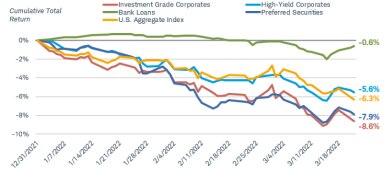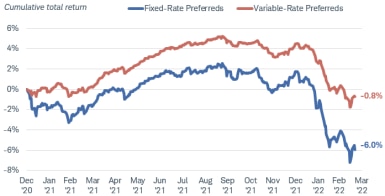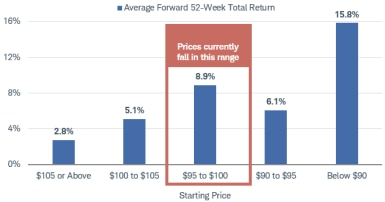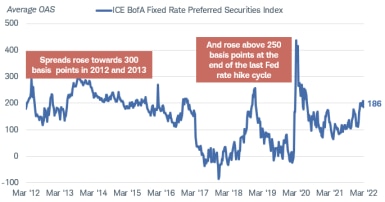Why to Consider Preferred Securities Now

Preferred securities prices have fallen sharply, presenting an attractive entry point for income-oriented investors who can ride out the volatility. Some caution is warranted, however, and we do think prices can fall modestly from here, given the heightened risks.
What risks? Well, the Federal Reserve has officially begun its rate hike cycle and the situation in Russia and Ukraine is weighing on sentiment, pulling down the prices of nearly all risk assets. In other words, we’re not calling a bottom. But for investors who have been frustrated by the low yields since the Fed dropped rates to near zero in 2020, this has presented an opportunity to lock in higher yields.
Yields up, prices down
Preferred security yields have risen sharply as their prices have plunged this year—the average yield-to-worst of the ICE BofA Fixed Rate Preferred Securities Index is now close to 5%, compared to its 10-year average of just 3.9%. That’s up sharply compared to the last year and a half; from July 2020 through December 2021, the average yield of the index was generally below 3%.
The drop in price was driven by the double whammy of higher long-term Treasury yields and falling stock prices. Because preferred securities are hybrid securities that share characteristics of both stock and bonds, they are influenced by both markets. The average price of the ICE BofA Fixed Rate Preferred Securities Index is now roughly $96, well below its recent peak of $108 in July 2021. While the price plunge may spook investors that currently hold preferreds, we think the entry point is looking more attractive.
Over the last 20 years, the average price of the index has rarely been lower than where it is today. There are two clear outliers: the 2008-2009 financial crisis and the pandemic-induced plunge in March 2020. Note that the chart below is truncated at $80 to illustrate where today’s price sits relative to non-crisis periods.
Over the last 20 years, prices haven’t fallen much below current levels
Source: Bloomberg, using weekly data as of 3/22/2022. Y axis is truncated at $80 for scale; the actual low was $38.60 on 3/6/2009. Note that average price of the preferred index is rebased to $100, despite many of its underlying holdings having par values of $25. As a result, the price fluctuations of $25 par value preferreds wouldn’t likely be as large in dollar terms, but would be similar in percentage terms.) Indexes are unmanaged, do not incur fees or expenses, and cannot be invested in directly. Past performance is no guarantee of future results.
The price decline has resulted in one of the worst starts to a calendar year for the ICE BofA Fixed Rate Preferred Securities Index—the index is down 7.9% through March 22nd. That’s the second worst start to a year since 2010, trailing only the 2020 pandemic-induced plunge when the index dropped more than 20% early in the year.
Preferred securities are down sharply so far this year
Source: Bloomberg. Total returns from 12/31/2021 through 3/18/2022. U.S. Aggregate Index = Bloomberg U.S. Aggregate Bond Index (LBUSTRUU Index); Investment Grade Corporates = Bloomberg U.S. Corporate Bond Index (LUACTRUU Index); High-Yield Corporates = Bloomberg U.S. Corporate High-Yield Bond Index (LF98TRUU Index); Preferred Securities = ICE BofA Fixed Rate Preferred Securities Index (P0P1 Index); and Bank Loans = the S&P/LSTA Leveraged Loan Index (SPDAL Index). Total returns assume reinvestment of interest and capital gains. Indexes are unmanaged, do not incur fees or expenses, and cannot be invested in directly. Past performance is no guarantee of future results.
One way to combat interest rate risk with preferreds is by considering variable-rate or adjustable-rate preferreds. These preferreds either have floating coupon rates, or are structured as fixed-to-float, meaning that they begin with a fixed coupon rate and then after a specified amount of time has passed, they reset based on a short-term reference rate. A benefit of these types of preferreds is that they can reduce the interest rate risk and help limit the price declines if interest rates continue to rise. They aren’t insulated from all risks though—they still have credit risk just like fixed-rated preferreds. But the lower interest rate risk has helped them outperform traditional preferreds since the beginning of 2020.
Variable-rate preferreds have outperformed fixed rate preferreds since the beginning of 2021.
Source: Bloomberg. Total returns from 12/31/2020 through 3/22/2022. ICE BofA Fixed Rate Preferred Securities Index (P0P1 Index) ICE Variable Rate Preferred and Hybrid Securities Index (PVAR Index). Total returns assume reinvestment of interest and capital gains. Indexes are unmanaged, do not incur fees or expenses, and cannot be invested in directly. Past performance is no guarantee of future results.
Low prices can mean higher total returns, but expect a lot of volatility
Historically, a lower starting price translates to a higher total return over the next 12 months, as the chart below illustrates. The average returns are just that—averages—and they can still fluctuate, sometimes wildly, given the riskier nature of preferred securities. Focusing on the average starting price between $95 and $100, the average forward 52-week total return was close to 9%, but the worst return in that starting range was a 58% loss during the financial crisis.
Low prices have generally translated to higher returns down the road
Source: Schwab Center for Financial Research and Bloomberg. Forward 52-week total returns of the ICE BofA Fixed Rate Preferred Securities Index using weekly data from 5/5/1989 through 3/18/2021. Past performance is no guarantee of future results.
The recent price declines represent a potentially attractive opportunity for investors who can ride out some heightened volatility going forward. While the entry point looks attractive, we’d caution that additional price declines are still possible.
Risks are still elevated
One reason that additional price declines are possible is due to the changing characteristics of the preferred market over the years, such as the average coupon rate. With the declining trend of interest rates and bond yields for the past few decades, preferred issuers have been able to issue securities with lower coupons. The average coupon rate of the preferred index is just over 5% today, compared with more than 7% just 10 years ago. Given the lower coupon rate, that makes the price of the index more sensitive to rising interest rates. All else equal, a lower coupon rate increases an investment’s duration, a measure of interest rate sensitivity. If long-term yields continue to rise modestly, that could pull prices a little lower.
Credit risk—the risk that an issuer can’t make timely coupon or principal payments—is high, as well. You can see that through the rising spreads. A spread is the amount of yield an investment, like a bond or preferred security, offers above a comparable Treasury to compensate for the additional risks of holding that investment. The average spread of the preferred index has risen lately, but it’s still below some of the previous peaks over the last 10 years. Since a spread can be considered an indication of risk—when economic conditions are deteriorating, investors tend to require higher spreads over Treasuries—they may drift modestly higher given concerns about tighter financial conditions and the risks from the Russia/Ukraine conflict.
Spreads are a component of a preferred security’s yield, so higher spreads would likely result in lower prices. We’re not expecting spreads to rise meaningfully higher, however, since corporate fundamentals remain strong. U.S. banks, one of the largest issuers of preferred securities, remain well-capitalized, supported by the results of the 2021 Fed stress tests. A flat yield curve and credit concerns stemming from the Russia/Ukraine situation pose a risk to banks, but overall they’re in good shape to remain current on their coupon payments.
Also consider the credit quality of any preferred security investment. Preferreds issued by large financial institutions tend to have credit ratings at the low end of the investment-grade scale or the high end of the sub-investment-grade spectrum, also called high-yield or “junk.” The average credit rating of the securities in the ICE BofA Fixed Rate Preferred Securities Index is “BBB.” Our outlook here is for those preferreds that fall in that range; there are lot of smaller preferred securities that have lower ratings or no ratings at all, and we consider them riskier.
Spreads do have a little room to rise
Source: Bloomberg, using weekly data as of 3/18/2022. Option-adjusted spreads are quoted as a fixed spread, or differential, over U.S. Treasury issues. OAS is a method used in calculating the relative value of a fixed income security containing an embedded option, such as a borrower's option to prepay a loan. Past performance is no guarantee of future results.
What to do now
Income-oriented investors who can handle heightened volatility should consider preferreds today. But before you dive in, understand that risks are still elevated. The risk of higher long-term yields as the Fed continues to hike rates could mean preferred yields go up (and prices down). Also, geopolitical risks could result in a flight-to-safety, where investors shift to more conservative investments and out of riskier investments like preferreds. That could pull prices lower, as well.
But for those investors who can ride out the ups and down, preferred securities appear attractive. With an average yield-to-worst of roughly 5%, the ICE BofA Fixed Rate Preferred Securities Index offers higher yields than most fixed income investments today. We always suggest that investors consider preferreds as long-term investments given their long maturity dates, or no maturity dates at all.
There are a number of ways to invest in preferred securities. Schwab clients can use the Preferred Shares Screener, can search for funds using the ETF Screener or Mutual Fund Screener, or explore funds on the ETF Select List , searching for funds under the “Preferred Stock” category. You can also consider a separately managed account.
What You Can Do Next
Follow the Schwab Center for Financial Research on Twitter: @SchwabResearch.
Talk to us about the services that are right for you. Call a Schwab Fixed Income Specialist at 877-566-7982, visit a branch, find a consultant or open an account online.
Explore Schwab’s views on additional fixed income topics in Bond Insights.
 By
By
